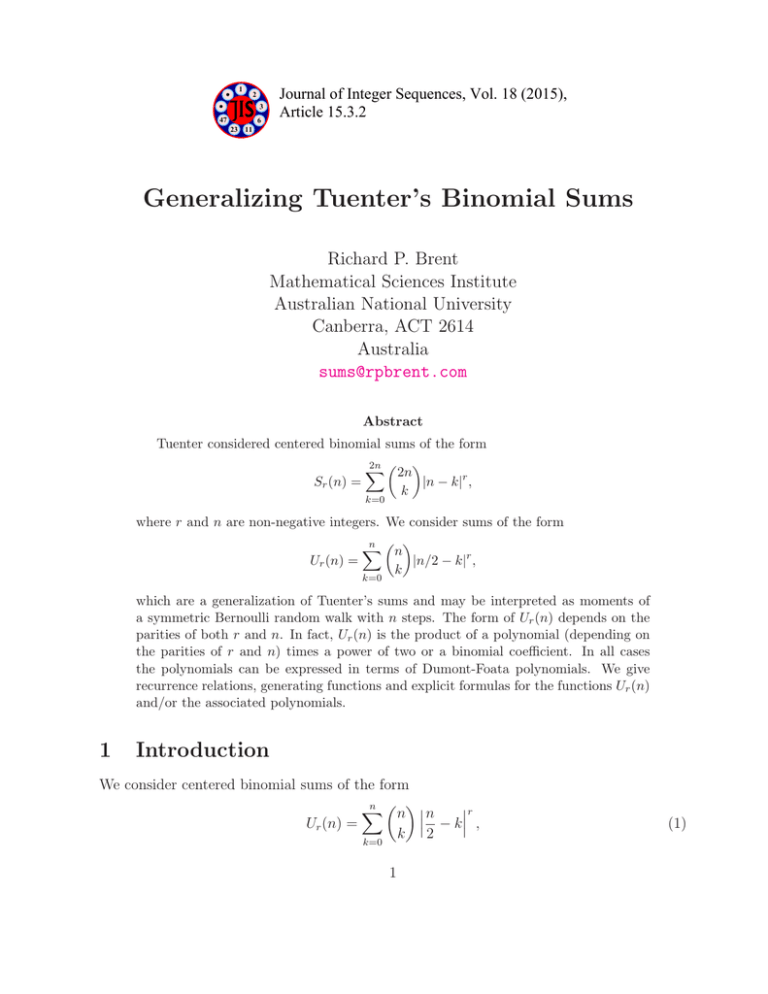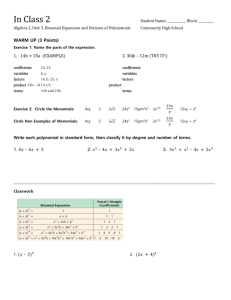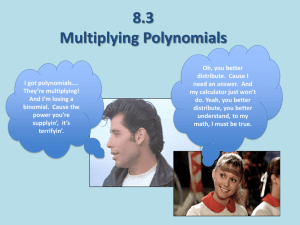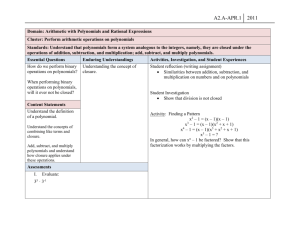Generalizing Tuenter’s Binomial Sums
advertisement

1 Journal of Integer Sequences, Vol. 18 (2015), Article 15.3.2 2 3 47 6 23 11 Generalizing Tuenter’s Binomial Sums Richard P. Brent Mathematical Sciences Institute Australian National University Canberra, ACT 2614 Australia sums@rpbrent.com Abstract Tuenter considered centered binomial sums of the form 2n X 2n Sr (n) = |n − k|r , k k=0 where r and n are non-negative integers. We consider sums of the form n X n Ur (n) = |n/2 − k|r , k k=0 which are a generalization of Tuenter’s sums and may be interpreted as moments of a symmetric Bernoulli random walk with n steps. The form of Ur (n) depends on the parities of both r and n. In fact, Ur (n) is the product of a polynomial (depending on the parities of r and n) times a power of two or a binomial coefficient. In all cases the polynomials can be expressed in terms of Dumont-Foata polynomials. We give recurrence relations, generating functions and explicit formulas for the functions Ur (n) and/or the associated polynomials. 1 Introduction We consider centered binomial sums of the form n r X n n Ur (n) = − k , k 2 k=0 1 (1) where r, n ≥ 0. These generalize the binomial sums Sr (n) = 2n X 2n k k=0 |n − k|r , (2) previously considered by Tuenter [7] and other authors, since Sr (n) = Ur (2n), but Ur (n) is well-defined for both even and odd values of n. The generalization in the naturally P P arises 2n 2n P (j, k), see study of certain two-fold centered binomial sums of the form j k n+j n+k Brent et al. [2, Lemma 6.4]. In definitions such as (1) and (2) we always interpret 00 as 1. Thus U0 (n) = 2n for all n ≥ 0. We define Ur (m) = 0 if m < 0. For r > 0 we can avoid the absolute value function in (1) by writing Ur (n) = 2 ⌊n/2⌋ X k=0 r n n −k . k 2 Tuenter [7] showed in a direct manner that, for r ≥ 0 and n > 0, Sr (n) satisfies the recurrence Sr+2 (n) = n2 Sr (n) − 2n(2n − 1)Sr (n − 1). (3) Observe that this recurrence splits into two separate recurrences, one involvingodd values . It follows of r and the other involving even values of r. Also, S0 (n) = 22n and S1 (n) = n 2n n that, for r, n ≥ 0, 2n 2n−r , (4) S2r (n) = Qr (n)2 and S2r+1 (n) = Pr (n)n n where Pr (n) and Qr (n) are polynomials of degree r with integer coefficients, satisfying the recurrences Pr+1 (n) = n2 Pr (n) − n(n − 1)Pr (n − 1), Qr+1 (n) = 2n2 Qr (n) − n(2n − 1)Qr (n − 1) (5) (6) for r ≥ 0, with initial conditions P0 (n) = Q0 (n) = 1. The Dumont-Foata polynomials Fr (x, y, z) are 3-variable polynomials satisfying the recurrence relation Fr+1 (x, y, z) = (x + z)(y + z)Fr (x, y, z + 1) − z 2 Fr (x, y, z) (7) for r ≥ 1, with F1 (x, y, z) = 1. Dumont and Foata [4] gave a combinatorial interpretation for the coefficients of Fr (x, y, z) and showed that Fr (x, y, z) is symmetric in the three variables x, y, z. 2 Tuenter [7] showed that Pr (n) and Qr (n) may be expressed in terms of Dumont-Foata polynomials. In fact, for r ≥ 1, Pr (n) = (−1)r−1 nFr (1, 1, −n) and Qr (n) = (−2)r−1 nFr ( 21 , 1, −n). (8) Thus, we can obtain explicit formulas and generating functions for the polynomials Pr (n) and Qr (n) as special cases of the results of Carlitz [3] on Dumont-Foata polynomials. We show that all the above results for Sr (n) can be generalized to cover Ur (n). In particular, Theorem 1 shows that Ur (n) satisfies a recurrence (9) similar to the recurrence (3) satisfied by Sr (n). Also, Ur (n) is the product of a polynomial (depending on the parity of r) times a power of two or a binomial coefficient, and Theorem 2 shows that these polynomials satisfy three-term recurrence relations analogous to (5)–(6). Using the recurrences, the polynomials can be expressed in terms of Dumont-Foata polynomials, so the results of Carlitz allow us to obtain explicit formulas (in §3) and exponential generating functions (in §4). 2 Recurrence relations Theorems 1–2 give recurrence relations for Ur (n) and associated polynomials. The recurrence (9) in Theorem 1 implies the recurrence (3) satisfied by Sr (n). Theorem 1. For all r, n ≥ 0, Ur (n) satisfies the recurrence 4Ur+2 (n) = n2 Ur (n) − 4n(n − 1)Ur (n − 2), (9) and may be computed from the recurrence using the initial conditions 2n 2n n for all n ≥ 0. , U1 (2n + 1) = (2n + 1) U0 (n) = 2 , U1 (2n) = n n n Proof. We have n n r+2 X r X n n n n 4Ur+2 (n) = 4 − k = − k (n − 2k)2 , k 2 k 2 k=0 k=0 n r X n n n Ur (n) = − k n2 , 2 k k=0 2 and n−2 X r n − 2 n − 2 4n(n − 1)Ur (n − 2) = 4n(n − 1) − k 2 k k=0 n−1 r X n − 2 n = 4n(n − 1) − k k−1 2 k=1 n−1 r X n n = 4k(n − k) − k . k 2 k=1 (10) (11) 3 (12) Since (n − 2k)2 − n2 − 4k(n − k) = 0, the recurrence (9) follows from (10)–(12). For the initial conditions, it is easily verified that U0 (n) = 2n . The solution by Hillman [5] n−1 , and taking account of the parity of n to the Putnam problem 35-A4 gives U1 (n) = n ⌊n/2⌋ gives the remaining conditions. It is now clear that the structure of Ur (n) depends upon the parities of both r and n, and one can elucidate the recursion (9) by the following substitutions: 2n −(2r+1) , (13) U2r+1 (2n − 1) = 2 nP r (n) n U2r (2n + 1) = 22n+1−2r Qr (n). (14) It is easily verified that P r (n) and Qr (n) are polynomials in n of degree r. By substitution into (9), we obtain the following theorem. Theorem 2. For r ≥ 0, the polynomials P r (n) and Qr (n) defined by equations (13)–(14) satisfy the following recurrence relations: P r+1 (n) = (2n − 1)2 P r (n) − 4(n − 1)2 P r (n − 1), 2 Qr+1 (n) = (2n + 1) Qr (n) − 2n(2n + 1)Qr (n − 1), (15) (16) with initial conditions P 0 (n) = Q0 (n) = 1. 3 Explicit formulas Using the recurrence (7) and matching the initial conditions, we can verify that the polynomials P r (n) and Qr (n) can be expressed in terms of Dumont-Foata polynomials, as follows: (17) P r (n) = (−4)r Fr+1 12 , 21 , 21 − n , (18) Qr (n) = (−1)r−1 22r−1 n + 12 Fr 21 , 1, −n − 21 . Also, replacing n by n + 1 2 in the second half of (8) shows that Qr (n) = 2r Qr n + 1 2 . (19) Carlitz [3, eqns. (1.13) and (1.16)] gives an explicit formula for the Dumont-Foata polynomials. We follow Carlitz and let (z)k denote the Pochhammer symbol or “rising factorial”. Note that, although Fr+1 (x, y, z) is symmetric in x, y and z, the representation given in Proposition 3 is not symmetric. Thus, it is sometimes necessary to permute variables before applying Proposition 3. 4 Proposition 3 (Carlitz). For r ≥ 0 and z > 0, Fr+1 (x, y, z) = r X (−1)r−k (x + z)k (y + z)k Ar,k (z), k=0 k 2r+1 2 X k−j k (z + j) . (−1) Ar,k (z) = k! j=0 j (2z + j)k+1 where Application of Proposition 3 gives, after some simplification, the following formulas for Ur (n), valid for r ≥ 1 and n ≥ 0: 1 n X − 2 k 2 k j 2r , (20) (−1)j U2r (n) = 2n+1 (k − j)!(k + j)! 1≤j≤k≤r X 2n (−n)k U2r+1 (2n) = 2n (−1)j j 2r , (21) n 1≤j≤k≤r (k − j)! (k + 1)j X 2r−1 (−n)k 2n . (22) j − 21 (−1)j U2r−1 (2n − 1) = (k − j)! (k)j n 1≤j≤k≤r 4 Generating functions The exponential generating function (egf) z 2r = 2n coshn (z/2). (2r)! (23) z 2r S2r (n) = 22n cosh2n (z/2) (2r)! r≥0 (24) X U2r (n) r≥0 generalizes the egf X given by Tuenter [7, §5], since replacing n by 2n in (23) gives (24). The proof of (23) is straightforward, and does not require the results of Carlitz. We can obtain other egfs from the results of Carlitz. First, we note that Carlitz [3, eqn. (4.2)] gives the egf X (−1)r Fr (x, y, 1) r≥1 z 2r 1 X (x)k (y)k z 2k = (−1)k 2 sinh . (2r)! xy k≥1 (2k)! 2 (25) In view of (4) and (8), this allows us to obtain an egf for U2r+1 (2n): X −1 n z z 2r 2n 2k 2k n . U2r+1 (2n) =n 2 sinh2k (2r)! n 2 k k r≥0 k=0 X 5 (26) In order to calculate U2r+1 (2n) from (26), it is only necessary to sum the terms on the right-hand side for k ≤ min(r, n). The remaining case U2r+1 (2n − 1) is more difficult because (25) does not apply. We can use the egf X (−1)r Fr+1 (x, y, z) r≥0 = 2 u2r+1 (2r + 1)! k ∞ X X (−1)j (x + z)k (y + z)k (2z)j sinh((z + j)u), j!(k − j)!(2z) (2z + k + 1) k+1 j k=0 j=0 (27) which follows from the discussion in Carlitz [3, pp. 221–222]. Using (13), (17) and (27), after some simplification followed by a change of variables (u 7→ z), we obtain the egf: X U2r+1 (2n − 1) r≥0 2n = n n z 2r+1 (2r + 1)! X (−1)k−j 0≤j≤k<n n−1 k 2k k 2k k−j sinh j + 12 z , j+k+1 (28) which is valid for n ≥ 1. 5 Acknowledgment Thanks are due to an anonymous referee for detailed and helpful comments on a preliminary version of this paper. This research was supported by Australian Research Council grant DP140101417. 6 Appendix 1: The polynomials P r , Qr for r ≤ 5 P 0 (n) = 1, P 1 (n) = 4n − 3, P 2 (n) = 32n2 − 56n + 25, P 3 (n) = 384n3 − 1184n2 + 1228n − 427, P 4 (n) = 6144n4 − 29184n3 + 52416n2 − 41840n + 12465, P 5 (n) = 122880n5 − 829440n4 + 2258688n3 − 3076288n2 + 2079892n − 555731, Q0 (n) = 1, Q1 (n) = 2n + 1, Q2 (n) = 12n2 + 8n + 1, Q3 (n) = 120n3 + 60n2 + 2n + 1, Q4 (n) = 1680n4 − 168n2 + 128n + 1, Q5 (n) = 30240n5 − 25200n4 + 5040n3 + 7320n2 − 2638n + 1. A similar table for Tuenter’s polynomials Pr (n), Qr (n) may be found in Brent [1]. The triangles of coefficients of −Pr (−n)/n, −Qr (−n)/n, and Qr (−n) for r ≥ 1 are OEIS [6] sequences A036970, A083061, and A160485 respectively. We have contributed the coefficients of P r (n) as sequence A245244. The values (−1)r P r (0) are sequence A009843 (see Appendix 2 for details). The bijection (19) between A083061 and A160485 (by a shift of ± 12 and scaling by a power of 2) was not mentioned in the relevant OEIS entries as at July 14, 2014; we have now contributed comments to this effect. Appendix 2: Special values of Pr , Qr , P r , Qr In Table 1, we give values of the polynomials Pr , Qr , P r , and Qr at 0, 1, ∞. Here P (∞) denotes the leading coefficient of the polynomial P (z), δi,j is the Kronecker delta, and Sr is the r-th Secant number. The values (−1)r P r (0) are OEIS sequence A009843, and are given by the egf ∞ X x2r+1 x . P r (0) (29) = (2r + 1)! cosh x r=0 They may be expressed in terms of the Secant numbers Sr , which comprise OEIS sequence A000364. In view of (17), we obtain a special value of the Dumont-Foata polynomials: Fr+1 21 , 21 , 12 = 2−2r (2r + 1)Sr . (30) 7 z Pr (z) Qr (z) P r (z) Qr (z) 0 1 ∞ δ0,r 1 r! δ0,r max(1, 2r−1 ) (2r)!/(2r r!) (−1)r (2r + 1)Sr 1 22r r! 1 (3 + 3)/4 (2r)!/r! 2r Table 1: Special values of the polynomials The values Qr (1) comprise OEIS sequence A054879. The values in the last row of Table 1 may also be found in OEIS: they are sequences A000142, A001147, A047053, and A001813. Tuenter [7] observed that, for r ≥ 1, the constant terms of −Pr (n)/n are the Genocchi numbers (A001469), and the constant terms of (−1)r−1 Qr (n)/n are the reduced tangent numbers (A002105). References [1] R. P. Brent, Generalising Tuenter’s binomial sums, preprint, http://arxiv.org/abs/1407.3533v4/, January 19 2015. [2] R. P. Brent, H. Ohtsuka, J. H. Osborn, and H. Prodinger, Some binomial sums involving absolute values, preprint, http://arxiv.org/abs/1411.1477v1/, November 6 2014. [3] L. Carlitz, Explicit formulas for the Dumont-Foata polynomial, Discrete Math. 30 (1980), 211–225. [4] D. Dumont and D. Foata, Une propriété de symétrie des nombres de Genocchi, Bull. Soc. Math. France 104 (1976), 433–451. [5] A. P. Hillman, The William Lowell Putnam mathematical competition, Amer. Math. Monthly 82 (1975), 905–912. [6] OEIS Foundation Inc., The On-Line Encyclopedia of Integer Sequences, published electronically at http://oeis.org. [7] H. J. H. Tuenter, Walking into an absolute sum, Fibonacci Quart. 40 (2002), 175–180. 2010 Mathematics Subject Classification: Primary 05A10; Secondary 11B65, 05A15, 05A19, 44A60, 60G50. Keywords: Bernoulli random walk, binomial sum identity, Catalan number, Dumont-Foata polynomial, explicit formula, generating function, Genocchi number, moment, polynomial interpolation, secant number, tangent number. 8 (Concerned with sequences A000142, A000364, A001147, A001469, A001813, A002105, A009843, A036970, A047053, A054879, A083061, A160485, and A245244.) Received July 16 2014; revised versions received January 18 2015; January 25 2015. Published in Journal of Integer Sequences, January 26 2015. Return to Journal of Integer Sequences home page. 9








